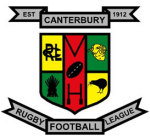
Tribute to Canterbury Rugby League - Significant Results and Famous players
1912 - 2024

|
Tribute to Canterbury Rugby League - Significant Results and Famous players1912 - 2024 |

|
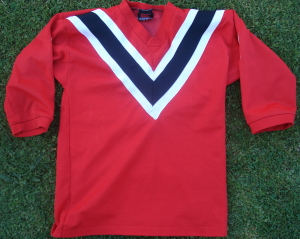
|
Maea David scoring try for Canterbury v Great Britain '92 at Addington Showgrounds |
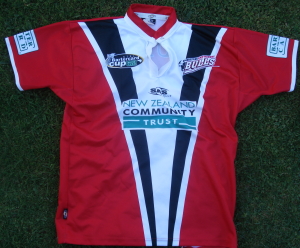
|
Thanks to John Coffey's (renowned Christchurch Press journalist) excellent book the "Canterbury XIII" (1987) and research of Lion Red Rugby League annuals between 1986 - 1999 made the list below possible. No accurate match by match statistics exist for Canterbury Provincial Rugby League. John Coffey for the history up until 1986 had to spend many hours at the Canterbury Public Library researching old newspapers etc. Beating Auckland was a rarity for both Canterbury & Wellington, so those results take pride of place below. The Lion Red Cup replaced Provincial Rugby League between 1994 - 96. Canterbury was split into 2 teams (Christchurch City Shiners & Canterbury Reds/Cardinals). Little success was met by either team, and the competiton folded in 1996 with large debts. Was the forerunner to the more successful Bartercard Cup (below) and the Canterbury Bulls Rugby League team. Unfortunately the Bartercard Cup competition was scrapped after the 2007 season, and domestic rugby league in NZ reverted to the provincial set-up that existed up until 1993.
| Opponents | Location | Year | Score |
| Auckland | Christchurch | 1925 | 6 - 5 |
| Auckland | Auckland | 1955 | 18 - 18 |
| France | Christchurch | 1955 | 24 - 13 |
| Auckland | Christchurch | 1962 | 16 - 13 |
| Auckland | Auckland | 1963 | 10 - 10 |
| Auckland | Auckland | 1975 | 15 - 14 |
| Auckland | Christchurch | 1985 | 22 - 22 |
| St Helens (UK) | Christchurch | 1985 | 30 - 24 |
| Auckland | Christchurch | 1990 | 25 - 22 |
| Great Britain | Christchurch | 1990 | 18 - 10 |
| Auckland | Christchurch | 1991 | 33 - 24 |
| Western Suburbs Magpies (Sydney) | Christchurch | 1991 | 18 - 18 |
| Auckland | Christchurch | 1992 | 8 - 8 |
| Auckland | Christchurch | 1993 | 40 - 12 |
| Auckland (First Division Grand Final) | Christchurch | 1993 | 36 - 12 * |
| Auckland | Christchurch | 1994 | 28 - 20 |
| Auckland | Christchurch | 1997 | 32 - 26 |
| Otahuhu Leopards (Bartercard Cup Grand Final) | Auckland | 2000 | 38 - 24 ** |
| Marist Richmond Brothers (Bartercard Cup Grand Final) | Auckland | 2003 | 32 - 28 ** |
| Auckland | Christchurch | 2008 | 36 - 30 |
| Auckland | Christchurch | 2009 | 32 - 30 |
| Auckland (Bartercard Cup Provincial Final) | Christchurch | 2009 | 26 - 20 * |
| Counties Manukau Stingrays (Pirtek National Premiership) | Auckland | 2014 | 40 - 8 * |
| Akarana Falcons | Auckland (Pulman Park) | 2019 | 28 - 18 |
| NSW Country | Christchurch (Nga Puna Wai) | 2019 | 17 - 16 |
* First Division Provincial/Bartercard Cup Champions: 1993, 2009, 2014
** (Franchise) Bartercard Cup Champions: 2000, 2003
For all the latest news related to Rugby League in Canterbury, goto these sites:
By TONY SMITH - The Press
The captains and coach of some of Canterbury rugby league's finest teams agree there is nothing better than beating Auckland.
The Auckland Rugby League has honoured a rivalry stretching back to 1912 by inviting the Canterbury Bulls to play at their centennial in Auckland today.
This appointment has brought back happy memories for key personnel from three of Canterbury's greatest victories over the blue-clad aristocrats from Auckland.
Mel Cooke is a Legend of League, a workaholic loose forward, and the only Cantabrian named in the Greatest Team of the Twentieth Century.
In 1962, Cooke was captain of the first Canterbury team to win the Rugby League Cup (then known as the Northern Union Cup) off Auckland at the Addington Showgrounds.
He remembers it like it was yesterday. "They came down with pretty much a full Kiwis team. Only their loose forward never represented the Kiwis. We had just three Kiwis at the time our wing Allen Amer, [stand-off half] Jim Bond and me."
The Aucklanders boasted some of the game's greats, including the prince of centres Roger Bailey, try-scoring wing Ken McCracken and backrowers Ron Ackland and Don Hammond.
"But we'd managed to keep a team together for two or three seasons and it was brilliant to beat them," Cooke said.
Auckland led 13-6 with 10 minutes remaining, but Canterbury fullback Tony Smith kicked a penalty to cut the deficit to five points.
Cooke helped create Canterbury's first try, combining with frontrowers Geoff Cooper and Gary Blackler to send wing Pat White scampering to score in the corner. Smith tied the score at 13-13 with his conversion.
Scrum-half Bob Irvine burrowed over later to give Canterbury a 16-13 victory after Bond foxed the Auckland defence with a dummy and linked with centre John Walshe.
Cooke said Canterbury went to Auckland to defend the cup in 1963 and drew with Auckland 10-10. "So we got to bring the cup home."
Canterbury team: Tony Smith, Pat White, John Walshe, Peter Smith, Allen Amer, Jim Bond, Bob Irvine George Turner, Gary Blackler, Geoff Cooper, Mita Mohi, Eddie Tavendale, Mel Cooke. Coach: Keith Roberts.
In 1975, Auckland had 14 players on Kiwis duty at the World Cup Canterbury had just two (prop John Greengrass and centre Bruce Dickison).
But new Canterbury coach Gary Clarke came in with a new broom and put his faith in a new young breed, including 19-year-old future Kiwis forward Mark Broadhurst.
Canterbury went into the game at the showgrounds unbeaten in the inter-districts competition after wins over Waikato, Wellington and West Coast.
Auckland scored two early tries, but Canterbury clawed their way back for a 15-14 win after tries to young skipper Wally Wilson and centres Lewis Hudson and Mocky Brereton.
The red-and-black resolve was exemplified by prop Stu Hogg, who had run himself to a standstill but who forcefully told coach Clarke, "there's no way I'm coming off".
All the squad got medals for winning the national championship, except Clarke, "because they didn't have enough". But Hudson "came in and gave his to me for my collection earlier this year".
Clarke said there was "nothing better than beating Auckland, especially up there at Carlaw Park".
Canterbury team: Jack Clarke, Gary Taie, Mocky Brereton, Leon Paskell, Lewis Hudson, Graeme Cooksley, Wally Wilson (capt), Stu Hogg, Dale Brown, Mark Fuller, Mark Broadhurst, Rex Dalzell, Mutu Stone. Reserves: Francis (Tiny) Lawrence, Alan Rushton. Coach: Gary Clarke.
In 1993, close to 10,000 people packed the showgrounds to see Frank Endacott's Canterbury record a celebrated 36-12 drubbing.
Canterbury captain Mark Nixon recalled Auckland bringing back their British-based professionals, including Kiwis Tawera Nikau, Tea Ropati and Duane Mann and ex-All Black Craig Innes. Canterbury's only returnee was the man Australia dubbed "the baby-faced assassin", Kiwi Brendon Tuuta.
But future Kiwi Logan Edwards "was on fire" for Canterbury.
"Logan worked a couple of blindside moves and suddenly we were 12-0 up and I hadn't even touched the ball," stand-off Nixon said.
"After the first one, he said to me `they don't know what to do let's do it again'."
"I don't think [Auckland centres] Innes and Iva Ropati enjoyed coming to Canterbury. Auckland used to call the showgrounds the killing fields back then."
The secret to the team's success was "our camaraderie", Nixon said. "Frank was big on that."
Canterbury team: Marty Crequer, Mike Dorreen, Blair Harding, Brett Rodger, Whetu Taewa, Mark Nixon (captain), Aaron Whittaker, Brent Stuart, Mike Culley, Ron Simanu, Simon Angell, Logan Edwards, Brendon Tuuta. Reserves: Justin Wallace, Shane Ngataki, Paul Johnson, Andrew Vincent. Coach: Frank Endacott.
(Stuff - Nothing better than bettering Auckland (2009), Tony Smith)| Year | Team | Year | Team | Year | Team | Year | Team |
| 1913 | Sydenham | 1947 | Sydenham | 1981 | Eastern Suburbs | 2015 | Papanui |
| 1914 | Sydenham | 1948 | Christchurch | 1982 | Addington | 2016 | Linwood |
| 1915 | Sydenham | 1949 | Prebbleton | 1983 | Hornby | 2017 | Linwood |
| 1916 | (NO COMPETITION) | 1950 | Sydenham | 1984 | Hornby | 2018 | Linwood |
| 1917 | Sydenham | 1951 | Linwood | 1985 | Halswell | 2019 | Linwood |
| 1918 | Sydenham | 1952 | Hornby | 1986 | Hornby | 2020 | Linwood |
| 1919 | Sydenham | 1953 | Sydenham | 1987 | Halswell | 2021 | Hornby |
| 1920 | Federal | 1954 | Sydenham | 1988 | Halswell | 2022 | Linwood |
| 1921 | Federal | 1955 | Sydenham | 1989 | Addington | 2023 | Linwood |
| 1922 | Sydenham | 1956 | Sydenham | 1990 | Hornby | ||
| 1923 | Addington | 1957 | Papanui | 1991 | Hornby | ||
| 1924 | Marist | 1958 | Hornby | 1992 | Papanui | ||
| 1925 | Marist | 1959 | Papanui | 1993 | Halswell | ||
| 1926 | Hornby | 1960 | Linwood, Papanui | 1994 | Papanui | ||
| 1927 | Hornby | 1961 | Linwood | 1995 | Halswell | ||
| 1928 | Marist | 1962 | Hornby | 1996 | Hornby | ||
| 1929 | Addington | 1963 | Linwood | 1997 | Hornby | ||
| 1930 | Hornby | 1964 | Hornby | 1998 | Papanui | ||
| 1931 | Addington | 1965 | Hornby | 1999 | Halswell | ||
| 1932 | Linwood | 1966 | Hornby | 2000 | Halswell | ||
| 1933 | Hornby | 1967 | Hornby | 2001 | Hornby | ||
| 1934 | Hornby | 1968 | Linwood | 2002 | Riccarton | ||
| 1935 | Addington | 1969 | Hornby | 2003 | Halswell | ||
| 1936 | Hornby | 1970 | Linwood | 2004 | Riccarton | ||
| 1937 | Addington | 1971 | Papanui | 2005 | Linwood | ||
| 1938 | Linwood | 1972 | Papanui | 2006 | Hornby | ||
| 1939 | Addington | 1973 | Papanui | 2007 | Kaiapoi | ||
| 1940 | Sydenham | 1974 | Papanui | 2008 | Linwood | ||
| 1941 | Sydenham | 1975 | Christchurch, Eastern Suburbs | 2009 | Hornby | ||
| 1942 | Hornby, Rakaia, Riccarton | 1976 | Papanui | 2010 | Hornby | ||
| 1943 | Sydenham, Rakaia | 1977 | Papanui | 2011 | Halswell | ||
| 1944 | Addington | 1978 | Papanui | 2012 | Hornby | ||
| 1945 | Sydenham | 1979 | Eastern Suburbs | 2013 | Hornby | ||
| 1946 | Rakaia | 1980 | Eastern Suburbs | 2014 | Halswell |
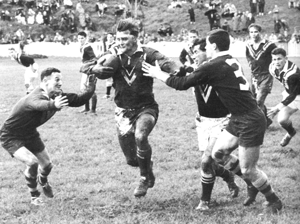
|
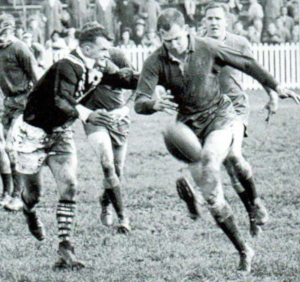
|
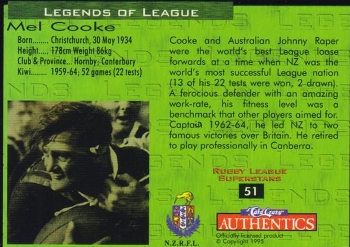
|
|
Mel Cooke scoring a great try, GB vs Kiwis 1st test 1961 Video snippet thanks to Rugby League Replayed |
||
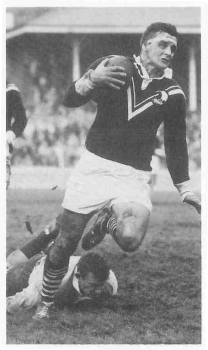
|
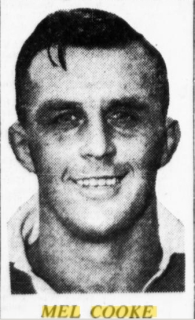 Mel Cooke in 1963
Mel Cooke in 1963Height: 1.78m Weight: 86kg |
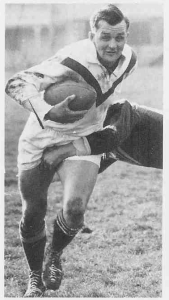
|
 Player of the year 1962 from Bruce Montgomerie's New Zealand Rugby League Book 1963
Player of the year 1962 from Bruce Montgomerie's New Zealand Rugby League Book 1963
"Cooke M. L. (Mel) 1959,60,61,62,63,64
Brilliant loose forward whose 22 tests were consecutive. Cooke scored 21 tries in his 53 Kiwi matches and was test captain against Great Britain (1962), on tour in Australia (1963), and against France (1964) before taking up a player-coach position in Canberra. While in Australia captained Monaro against the 1966 British tourists and was selected for New South Wales Country. In 1969 Cooke was back with Hornby (which he had captained to national tournament finals in 1962 and 1964 and also coached to a 1964 Thacker Shield victory) as non playing coach, a role he again filled in 1978. A try scorer in his test debut at the Sydney Cricket Ground in 1959; four years later, on his second Australian tour, he played scrum-half in the third test. Also travelled to the 1960 World Cup in England and to Britain and France in 1961. His debut for Canterbury was at scrum-half in 1953, but it was in his international position that he graduated from the 1958 and 1959 national coaching schools. Canterbury selector and coach in 1971."
(Canterbury XIII - HALL OF FAME; THE KIWIS 1907-1986 (1985), John Coffey, pg 189-190)
"It was a measure of Mel Cooke's greatness that the Canterbury loose forward was the only player to appear in all 18 tests between 1960 & 1964, the period in which New Zealand won the Courtney Goodwill Trophy as the most successful country in international rugby league. They where the bulk of Cooke's 22 consecutive tests, a sequence that began with a try-scoring debut in the 1959 third-test triumph over Australia in Sydney. He was captain for the last three seasons before accepting a player-coach position in Canberra in 1965, He later returned to New Zealand to coach his Hornby club and Canterbury.
Cooke was an inspiration, who also led Hornby, Canterbury and South Island to many notable victories. His cover defense was phenomenal, and the force of his front-on, ball-and-all tackles shook up many Kangaroos and Lions forwards of much bigger stature than his own 85 kg. 'He was a punishing tackler who really shook the cobwebs loose if he hit you unexpectedly', wrote Johnny Raper, Australia's equally revered loose forward of the same era. Cooke was fitter than the amateurs he played with and the professionals he played against, and this was explained as resulting from his remarkably low pulse rate (in the forties), which was discovered during the 1961 tour of Britain. First chosen for his province as a scrum-half in 1953, Cooke was also a clever attacking footballer and his finishing skills provided him with 21 tries in 52 games for the Kiwis."
(The Kiwis - 100 years of International Rugby League - Star players of the 1960s (2007), John Coffey and Bernie Wood, pg 222)
"1960-1969: THE COOKE INFLUENCE
No other player in Canterbury rugby league history exerted as much influence at every level of the game - inter-club, inter-provincial, inter-island and international - as Mel Cooke. His indefatigable work-rate and inspiring leadership for Hornby, Canterbury, South Island and New Zealand was reflected in the results achieved. Never more so than in 1962, when he captained Hornby to championship success, Canterbury to relieve Auckland of the Northern Union Cup, South to beat North without conceding a point, and the Kiwis to back-to-back record margin victories over Great Britain
Cooke debuted for Canterbury at scrum-half in 1953. But he developed into the finest loose forward of his era, challenged only by Australian champion Johnny Raper. On performances over five seasons from 1960 to 1964 New Zealand won the massive Courtney Trophy as rugby league's premier nation. Cooke alone appeared in all 18 of those Tests against the Kangaroos, Lions & Tricolours. He captained the Kiwis from 1962 until 1964. Having tamed the 1962 Lions, one controversial refereeing ruling cost them the 1963 series in Australia and Cooke retired after leading the 1964 Kiwis to a three-Test whitewash of France.
The NZRL granted him a clearance to play and coach in Canberra from 1965, a reward then accorded long-serving Kiwis. Before leaving, Cooke guided Hornby to the 1964 Canterbury title and to Thacker Shield victory over Greymouth Marist. Hornby also got within five points of Auckland champion Otahuhu in its third consecutive national tournament final. Hornby went on to win three more Canterbury championships through to 1967 as Cooke's former club-mates maintained the momentum. Cooke played for Monaro district against the 1966 Lions before returning to Canterbury in 1969, coaching his club and province."
Mel Cooke was one of the finest locks New Zealand ever produced. He played Rugby Union at school, as a halfback and five eighth, before turning to League. He first represented Canterbury province as a half in 1953, but then switched to the forwards. Twenty-one of his 22 consecutive Tests were at lock, the exception being the deciding 1963 Third Test at Sydney, when Cooke reverted to halfback because injury prevented Bill Snowden from playing.
Cooke had his first taste of representative football in 1959, touring Australia with the Kiwis, soon after representing South Island against North Island. He was to play 52 matches for his country between then and 1964. His finest hour came in 1962 when he led New Zealand to upset wins over the touring British Lions, fresh from a resounding truimph over Australia.
Cooke spent his final footballing years in Australia where he coached the Canberra side in a southern NSW competition. It was while playing there that Cooke made a brief return to the international scene, as captain of the Monaro representative team soundly beaten by the 1966 Lions.
Former Kiwis’ coach Frank Endacott walked to the funeral parlour podium, looked out at scores of Canterbury rugby league luminaries and thought: ‘‘We’re here to celebrate the greatest of them all’’ – Mel Cooke.
|
Named in NZRL team of the century
|
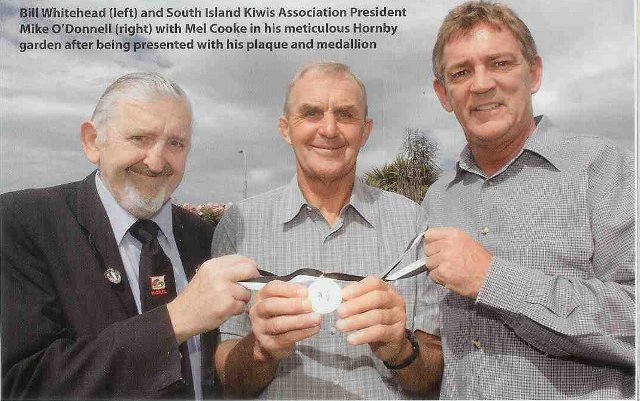 Mel Cooke accepting his NZRL Team of Century award
Mel Cooke accepting his NZRL Team of Century award(Super League - Team of the Century, Bill Whitehead, Photo Geoff Sloan, May 2008, pg 31) |
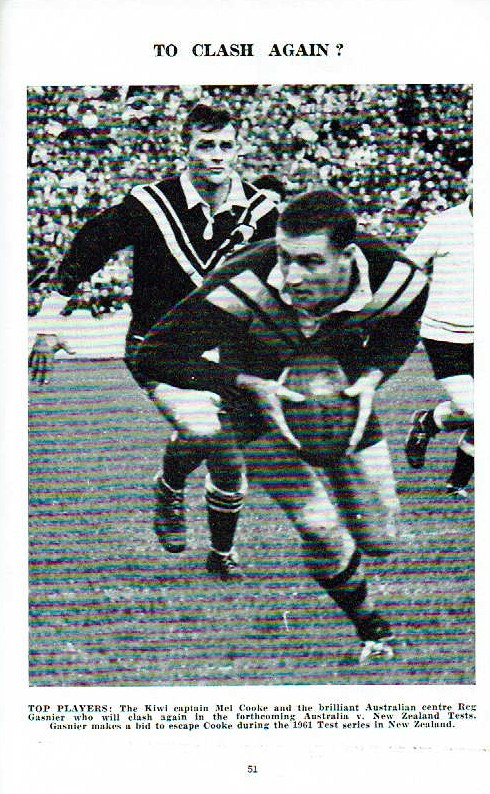 Mel Cooke tackling Kangaroos Reg Gasnier in 1961
Mel Cooke tackling Kangaroos Reg Gasnier in 1961 |
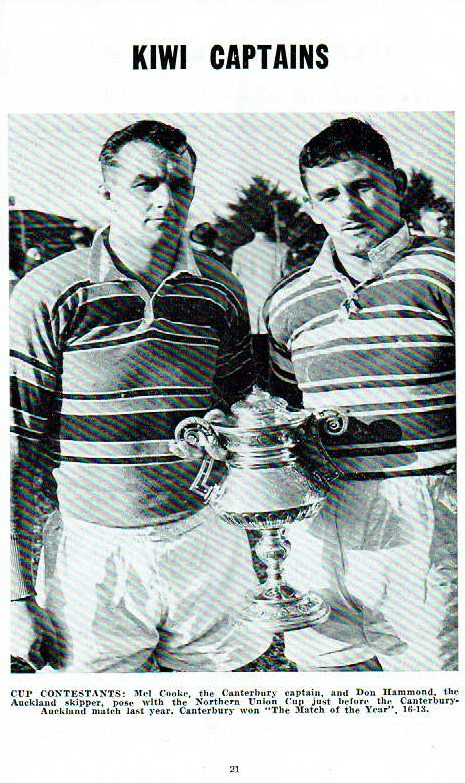 Mel Cooke and Don Hammond opposing Canterbury/Auckland captains in 1962
Mel Cooke and Don Hammond opposing Canterbury/Auckland captains in 1962 |
|
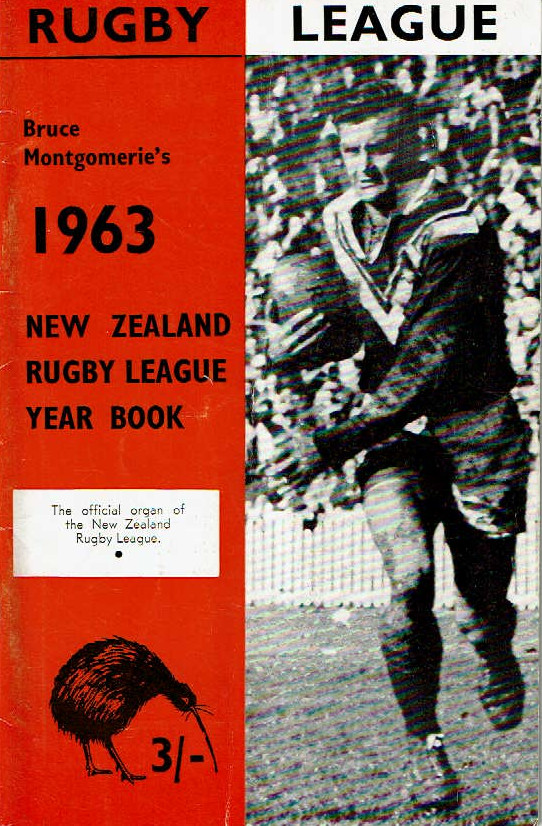 Front cover on Bruce Montgomerie's New Zealand Rugby League Book 1963
Front cover on Bruce Montgomerie's New Zealand Rugby League Book 1963
|
||
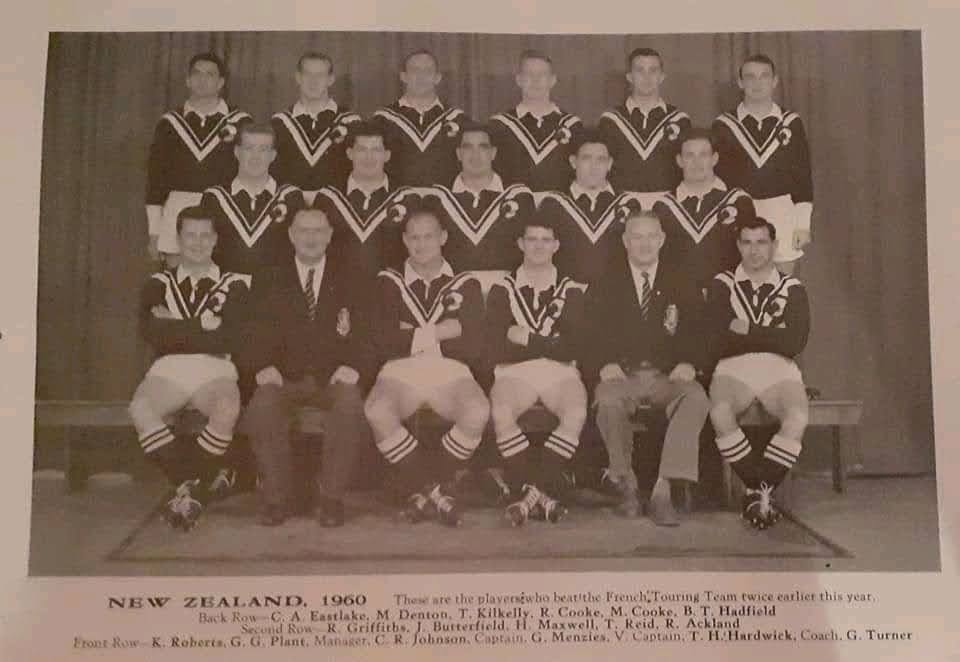 Mel Cooke in 1960 World Cup team lineup vs Kangaroos
Mel Cooke in 1960 World Cup team lineup vs Kangaroos
|
||
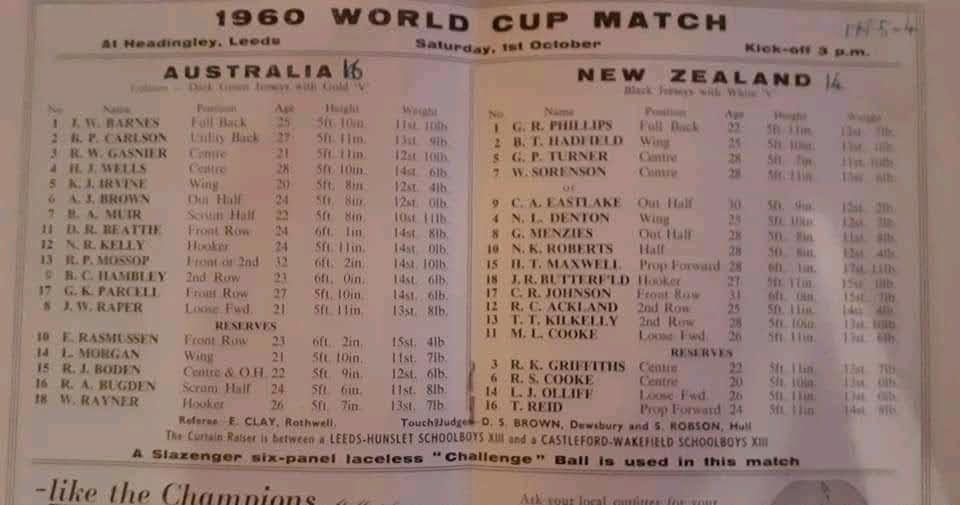 Mel Cooke in 1960 World Cup team stats vs Kangaroos
Mel Cooke in 1960 World Cup team stats vs Kangaroos |
||
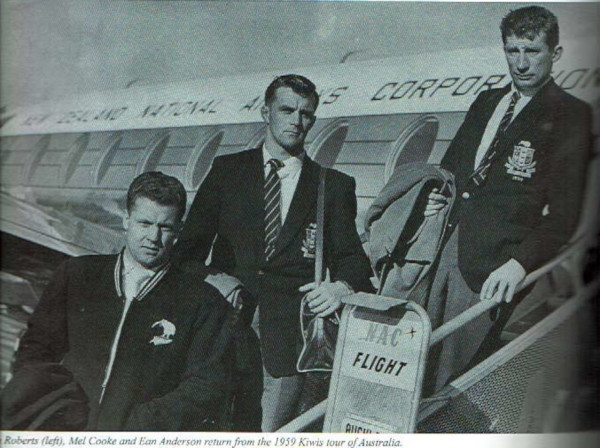 Mel Cooke returning from Australia in 1959
Mel Cooke returning from Australia in 1959 |
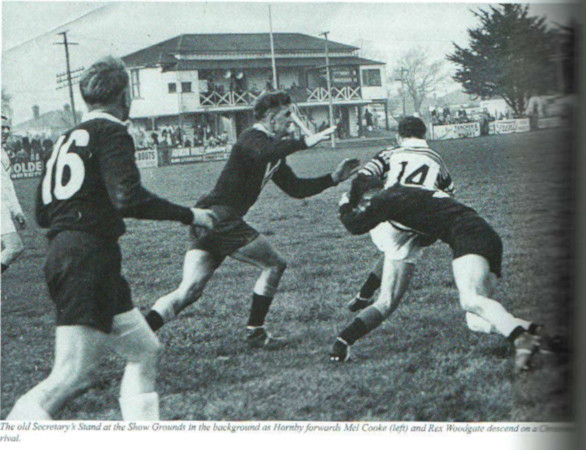 Mel Cooke in club football at the Addington Showgrounds
Mel Cooke in club football at the Addington Showgrounds |
|
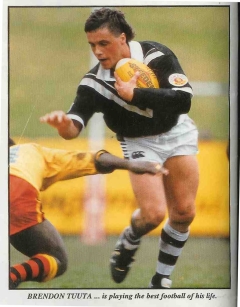
|
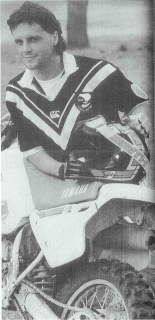
|
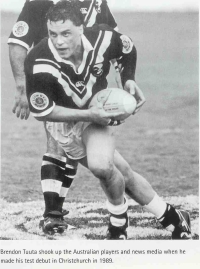
|
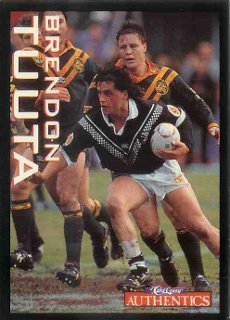
|
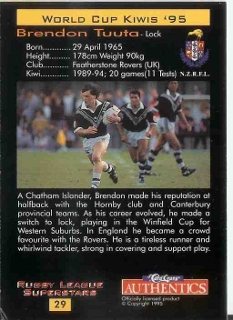
|
Learned that Brendon actually played 179 games for Featherstone. 172 starts and 7 sub appearances. And 32 tries. In two spells, 1990 to 1995 and in 1999. Thanks Mark!
If there is ever a need for a shibboleth to determine whether a person comes from Featherstone, then Brendon Tuuta would do nicely.
Ask a stranger for a thumbnail sketch of Tuuta as a rugby league player. If the words mad, bad or dangerous do not figure in the description, then it is safe to conclude that the speaker hails from within two miles of Post Office Road.
Tuuta, who will spearhead Rovers' tilt at Leeds in this Saturday's Silk Cut Challenge Cup semi-final, has always polarised opinion. His notoriety outside his adopted village is matched by the fierce loyalty he inspires within its narrow boundaries.
Take, on the one hand, this glowing account of his Test debut for New Zealand, against Australia in 1989, by an opponent, Paul Vautin.
"That Test he was dead-set mad. He went out there keen to get half a dozen Aussie heads to put on the mantlepiece. He was just a wild man from start to finish." After that Test in Christchurch, Tuuta inherited a nickname, recently vacated by Australia's own Les Boyd, that both he and the club dislike sufficiently to threaten their local paper with legal action if they use it.
It is unfair that Tuuta should be branded indelibly on the basis of one match six years ago, but there has been plenty of fuel to stoke the fires of prejudice against him since then, culminating in allegations of an assault on a fan at Workington earlier this year.
He is not now to be charged, but in Featherstone the conviction that Brendon Tuuta was innocent was always an article of faith.
"People here are very supportive towards him," said Chris Westwood, timekeeper, programme writer and prototypal Featherstone fan. "The view in Featherstone is that he hasn't done anything wrong and that anything that did happen wasn't initiated by him.
"He's a lovable rascal and people in Featherstone take to him for that."
Westwood points out the irony of the club's favourite local hero coming from just about as far away as it is possible to come.
"It's a paradox, because he comes from a place that no one in Featherstone would know existed if it wasn't for him."
In fact, Tuuta is, by some distance, the most celebrated person ever to come from Chatham Island, a fragment of offshore New Zealand 500 miles adrift in the Pacific east of Christchurch, which my guidebook describes as "a wild place. . . very much off the beaten track."
From Chatham Island, population 700, Tuuta graduated to playing in Christchurch and for two seasons with Western Suburbs in Sydney, one of them alongside the Leeds captain he will face on Saturday, Ellery Hanley.
It is in Featherstone, which must seem to a Chatham Islander like Auckland, New York and Gotham City rolled into one, that he has, since 1990, found a home from home.
As a loose forward, his relentless energy and aggression have always made up for his relative lack of bulk. Recently, however, he has reverted to his earlier position of stand-off, where his displays have shown how underrated his rugby ability has become.
Tuuta will never exacly be a stylist in the role, but he is always busy and often creative - exactly the sort of individual that players would rather have on their side than the opposition.
With his 30th birthday looming, Tuuta commits less obvious transgressions than in his youth as a wild man from a wild place, while still playing in a sort of cold-eyed fury.
"He gives so much on the field, which is all Featherstone fans ever really ask. You don't have to be the most gifted player, as long as you're prepared to put your body on the line," Westwood said. "Popular in Featherstone? Put it this way - if he was a candidate for mayor he would get in with a landslide."
First citizen of Chatham Island and Featherstone? Tuuta is big in all the small places, perhaps because that is where they appreciate a big heart.
(Independent, The (London), Mar 30, 1995 by DAVE HADFIELD)"...But much of the attention was directed at Brendon Tuuta, even though he had only been on the field for a few minutes. When we signed Brendon for Hornby I told him if I was selecting a boxing team he would always be first in. But he must improve his discipline on the league field. Everything was going okay until the Thursday training before the Thacker Shield when I went around the players individually, came to Brendon, and told him he had to 'harass' Runanga's Kiwi scrum-half Glen Gibb. Gibby was their playmaker, everything revolved around him, and it was vital he not be allowed to dicate play if we were to become South Island champions. Brendon looked up and said he understood what I meant. Just before the kick-off on match day I asked Brendon if he remembered his job and he replied, 'Yes, harass Glen Gibb.'.
The players went down the tunnel, Runanga almost scored immediately, and I was hardly in my seat up in the stand when referee Don Wilson's whistle had that note of urgency which makes coaches cringe. A scrum had broken up, Glenn Gibb was lying prone on the ground, and Brendon was trudging off for an early shower, moodily unwinding the arm bandage he always wore.
At halftime I went down to the dressing room, saw Brendon still sitting there, and began to give him a bollocking. 'Brendon, what happened out there? We're down to 12 men and that makes it bloody tough on the others', I said. He looked up in all innocence and said he had done when I had told him, to harass Glen Gibb. Suddenly it began to dawn on me. 'You harased him,' I said. 'Do you know what harass means?'. Brendon was all earnestness in replying, 'Yeah, it means eliminate.' Maybe they have different dictionaries in the Chatham Islands.
A few years later Brendon did some 'harassing' of the Kangaroos in a test match at Christchurch's Queen Elizabeth II Park and the Aussie media dubbed him the 'Baby-faced Assassin', a label which haunted him throughout a fine career n Australia and Britain as well as for the Kiwis. Brendon was the toughest player, pound for pound, that I ever coached, fit to be ranked along with the guys like Quentin Pongia and Jarrod McCracken. Clever too. I remember a mid-winter trip to Hastings to play Waipukurau in a national knock-out competition. We had just returned to our hotel wearing our best gear, blazers and all, when Brendon and Ross Taylor decided I was going in the pool as part of team bonding. I asked them to back off while I stripped off, so my clothes wouldn't get soaked before the trip home next day. I carefully put my gear on the ground and jumped in to keep them happy. Then, as I'm swimming back to the side of the pool, I looked up to see my clothes going into the water over the top of my head..."
(Being Frank - The Frank Endacott Story (2002), John Coffey, pg 30-31)"...He was tough and strong and undoubtably played above his weight (5 ft 10in, 13st 4lb), but his hard-running and ferocious tackling made him a most formidable opponent - and the crowds loved him. Off the field he was quiet and assuming!..."
"...This popular player certainly has a special place at Featherstone, where his whole-hearted efforts were an inspiration to the other players. Whilst his tackling and commitment were awesome, behind the ferocity was a very talented footballer who had an eye for the opening, could split passes and displayed some very silky skills..."
(100 Greats Featherstone Rovers Rugby League Football Club (2002), Ron Bailey, pg 121)
"...'I never played sport until I was 14. I just was not interested,' said Tuuta.
'We moved from the Chathams because one of my brothers accidently burnt the family house down.
My father moved us to Hornby in Christchurch.
Somehow Dad found himself coaching rugby league and I decided to give it a go.'
Tuuta proved to be a natural footballer and progressed rapidly through the grades.
At the age of 19, he returned briefly to the Chathams.
'My intention was to go back for two years, but I stayed only a few months and I returned to New Zealand. I missed the place badly.'..."
"...In his very first game for the Kiwis, against Aussie, he got in trouble for over-vigorous play and things were to become progressively worse.
'I couldn't do a damned thing right,' he said.
The press were to crucify Tuuta, and give him the unwanted label of the Baby-faced Assassin.
'I hated that name. The press ****** me off.
I was a marked man from the moment they gave me that name.
I know I lost a lot of first class games because of it.
I was targeted by the opposition all the time. Referees would penalise me for ridiculous things. It was madness. I had the confidence knocked out o fme. I had to get away from the place.
The press was my main reason for leaving Australia'.
Tuuta found his haven when he decided to try out with English club, Featherstone Rovers.
'I loved it in England. I wanted to stay.
I asked for a release from Western Suburbs and Featherstone Rovers bought out the remainder of my contract'.
I asked Tuuta if his reputation preceded him in England.
'No, the English press have been all right to me. I have been able to concentrate on just playing good football, that's all. I really want to do just that - play good football and enjoy my family'...".
"...as a player, he has that distinctive style which is unique to him: Ball pushed forward in both hands, head ans shoulders down and almost parallel to the ground. Then there's that constant weaving, probing motion..."
(Kiwi League Monthly (Jul 1992 Vol 4), Ray Phillips, pg 18-19) Links
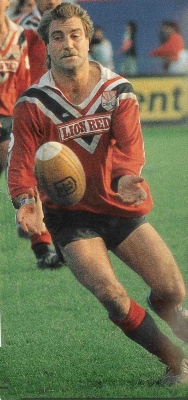
|
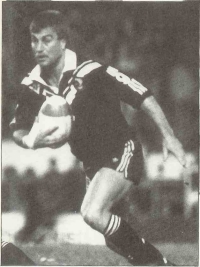
|
"...The sight of the young Hornby lad enthusiastically launching himself at any opponent within range rekindled in some observers memories of the great New Zealand backrower and captain Mel Cooke."
(Modern Rugby League Greats (1991), John Coffey, pg 213)
"Gradually Wallace earned acceptance in the No 9 Jersey, combining the attacking and defensive attributes which had stood him in good stead as a loose forward with the resilience needed in the front-row."
(Modern Rugby League Greats (1991), John Coffey, Pg 214)
"From the backrow berth Wallace could indulge in the free running which was a trademark of his displays for club and Canterbury. For some seasons there was no more devastating combination in the Canterbury premiership than Wallace and fullback Robin Alfeld. Before retiring to adopt the life of a country publican, Alfeld created a Hornby record of 116 tries. Many were created by the wily Wallace's ability to drift wide of the play-the-ball with no obvious devious intent, only to perfectly place a pass into the gap..."
(Modern Rugby League Greats (1991), John Coffey, Pg 214)
"...Wallace could switch back to the mundane responsibilities of a hooker. Wallace was a swift striker for the ball, before and after the rules were amended to take most of the uncertainty out of which team would win possession. He had a smooth pass from the acting-half position, and was quick to capitalise on any laxness in the opposing defense. Wallace's alertness gained him two test tries against Papua New Guinea. As his career advanced Wallace became an increasingly effective tactical kicker. He learned to launch a lethal up-and-under, to master length and direction with raking line kicks, to grubber the ball behind the defense or chip it over their heads. There was even a vital field goal in a tight encounter with Wellington."
(Modern Rugby League Greats (1991), John Coffey, Pg 215)
"Wallace's tackling was an emotive subject. He would descend upon the unfortunate ball-carrier with all the charity of an invading general hell bent on carrying out a scorched earth policy. There was a flailing of arms as Wallace sought to envelop the player ball and all as a prelude to crashing him to the turf. The margin for error was often very slender, and to the initiated Wallace might have given the impression he was a mission to maim. Many supporters of other clubs would be baying for Wallace's blood as he wrought his havoc upon their teams. Yet they would be cheering him on when he was serving the causes of Canterbury or New Zealand. It is unlikely that Wallace did any permanent damage, either to himself or his opponents."
(Modern Rugby League Greats (1991), John Coffey, Pg 215)
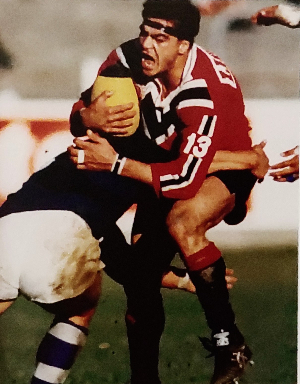
|
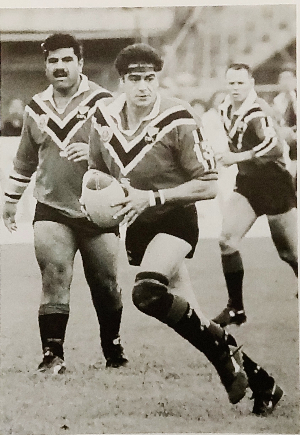
|
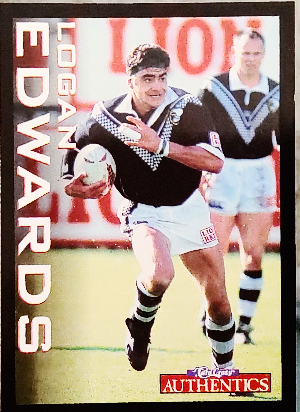
|
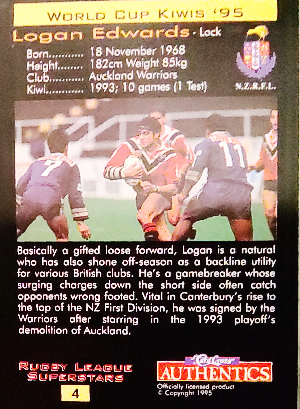
|
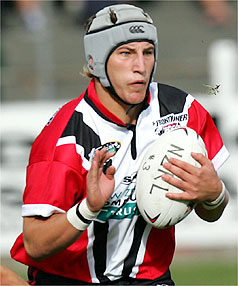
|
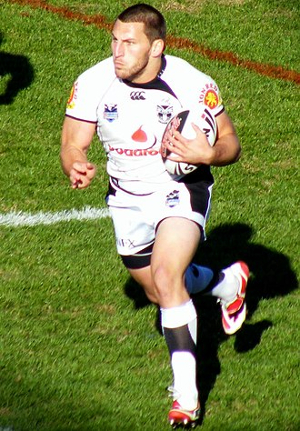
|